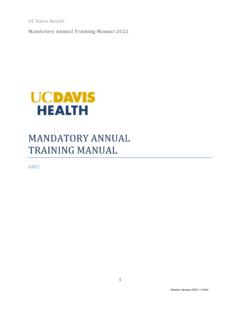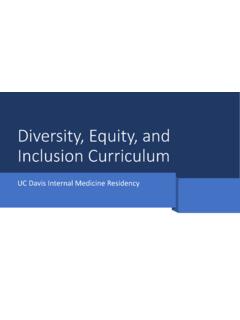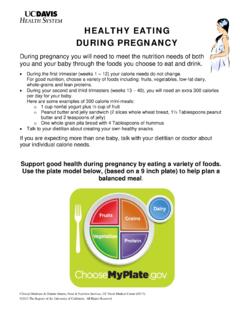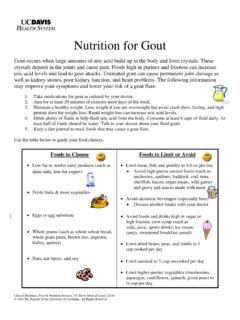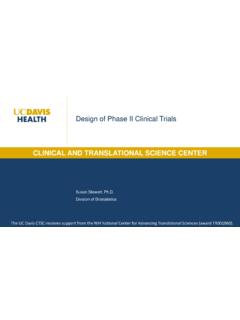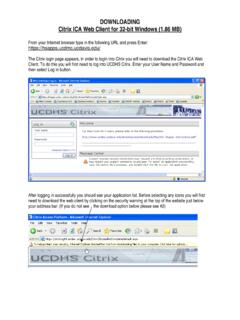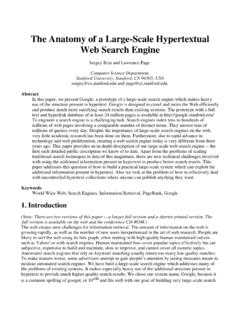Transcription of Design and Analysis of Case-Control Studies
1 Design and Analysis of Case-Control StudiesKyoungmi Kim, 9 & 16, 2016 This seminar is jointly supported by the following NIH-funded centers:We are video recording this seminar so please hold questions until the Objectives Introduce basic concepts, application, and issues of Case-Control Studies Understand key considerations in designing a Case-Control study, such as confounding and matching How to determine sample size for a prospective Case-Control studyCase-Control Studies Are used to retrospectivelydetermine if there is an association between an exposure and a specific health outcome. Proceed from effect ( health outcome, condition, disease) to cause (exposure). Collect data on exposure retrospectively. Are observational Studies because no intervention is attempted and no attempt is made to alter the course of the is a Case-Control Study Warranted?
2 A Case-Control study is usually conducted before a cohort or an experimental study to identify the possible etiology of the disease. It costs relatively less and can be conducted in a shorter time. For a given disease, a Case-Control study can investigate multiple exposures (when the real exposure is not known). A Case-Control study is preferred when the disease is rare because investigators can intentionally search for the cases. A cohort study of rare disease would need to start with a large number of exposed people to get adequate number of cases at the Case-Control Study Design (Look back in time) Assess prior exposure status at some specified time point before disease onset(Present) Selection of cases and controls based on health outcome or disease statusSelected by inclusion and exclusion criteriaA subset of the target population, randomly selected from the populationStudyPopulationStudy ParticipantsCase GroupExposedUnexposedControl GroupExposedUnexposedNon ParticipantsDetermine Association After the investigator determines the exposure, a table can be formed from the study data.
3 Assess whether exposure is disproportionately distributed between the cases and controls, which may indicate that the exposure is a risk factor for the health outcome under in the Design of Case-Control Studies Formulation of a clearly defined hypothesis As with all epidemiological or observational investigations the beginning of a Case-Control study should begin with the formulation of a clearly defined hypothesis. Case definition It is essential that the case definition is clearly defined at the outset of the investigation to ensure that all cases included in the study are based on the same diagnostic criteria. Source of cases The source of cases needs to be clearly defined. Selection of Cases Cases should be homogenous Criteria or definition of cases must be well formulated and documented If diagnostic tests are used to identify cases: High-sensitivity tests (same as broad criteria or definition) will yield a higher number of false positives Low-sensitivity tests (same as restrictive criteria or case definition), and thus high specificity, will result in a lower number of false positives A mild form of disease may also include higher false positives than a severe form of disease If cases are misclassified (include false positives), the association may be of Cases Cases may be recruited from a number of sources Can be recruited from a hospital, clinic, GP registers or may be population bases.
4 Population based Case-Control Studies are generally more expensive and difficult to conduct. Selection of Controls Conceptually, controls should come from the same population at risk of diseasefrom which cases develop. But practically, controls are often selected to be similar to cases on key factors but without the disease- because it is difficult to define the population at risk of disease. Different types of controls may be used, and they have different of Controls Hospital controls Have similar quality of information and are convenient to select, but they may have characteristics or diseases that led to hospitalization Dead controls If cases are dead, information of past exposures will be given by surrogates, such as spouse or children Best friend or neighbor controls May share similar characteristics Population controls Random digit dialing (RDD)
5 Is often usedMultiple Control Groups Because of the several limitations in the selection of controls, the use of multiple control groups may address some of the concerns Use both living controls and dead controls The use of surrogates to provide data Hospital controls and community controls Hospital controls may have some conditions that lead to frequent hospital visits Non-disease controls and cancer controls Recall of past exposure differs with outcome If findings are in agreement between groups, then they are likely to be validMeasuring Exposure Exposure is measured to assess the presence or level of exposure for each individual for the period of time prior to the onset of the disease or condition under investigation when the exposure would have acted as a casual factor. Note that in Case-Control Studies the measurement of exposure is established after the development of disease and as a result is prone to both recall and observer bias.
6 The procedures used for the collection of exposure data should be the same for cases and Exposure Various methods can be used to ascertain exposure status. These include: Standardized questionnaires Biological samples Interviews with the subject Interviews with spouse or other family members Medical records Employment records Pharmacy recordsSources of Bias in Case-Control Studies Recall Bias Occurs when the recall is better among cases than controls because of the presence of the disease. Selection bias Controls are used to provide an estimate of the exposure rate in the population. Therefore, selection bias may occur when those individuals selected as controls are unrepresentativeof the population that produced the cases. Selection bias may also be introduced when exposed cases are more likely to be selected than unexposed cases.
7 Analysis of Case-Control Studies The odds ratio (OR) is used in Case-Control Studies to estimate the strength of the association between exposure and outcome. Note that it is not possible to estimate the incidence of disease from a Case-Control study unless the study is population based and all cases in a defined population are obtained. The results of a Case-Control study can be presented in a 2x2 table (next slide).Measure of Incidence in Case-Control Studies Odds ratio (OR) == = CasesControlsExposedabUnexposedcdInterpr eting the odds ratio: OR = 1 Odds of disease is the same for exposed and unexposed OR > 1 Exposure increases odds of disease OR < 1 Exposure reduces odds of diseaseExample Conducted a Case-Control study to determine if there is an association between colon cancer and diet (high fat diet, coffee).
8 Cases were all confirmed colon cancer cases in CA in 2011. Controls were a sample of CA residents without colon cancer. OR= 4 in the study of high fat diet: Individuals who consumed a high fat diet have 4 times the odds of colon cancer than individuals who do not consume a high fat diet. OR= in the study of coffee consumption: The odds of colon cancer among coffee drinkers is only times the odds among individuals who do not consume coffee- thus coffee consumption seems to be protective against colon cancer. Case-Control Studies : Strengths Strengths Cost effective relative to other analytical Studies such as cohort Studies Case-Control Studies are retrospective, and cases are identified at the beginning of the study; therefore, there is no long follow-up period (as compared to cohort Studies ) Efficient for the study of diseases with long latency periods Allow to look at multiple exposures simultaneously Useful as initial Studies to establish an associationCase-Control Studies .
9 Weaknesses Weaknesses Particularly prone to bias, especially selection, recall and observer bias because they rely on memory and people with a condition will be more motivated to recall risk factors Case-Control Studies are limited to examining one outcome Unable to estimate incidence rates of diseases (unless study is population based) Poor choice for the study of rare exposures The temporal sequence between exposure and disease may be difficult to establish It can be difficult to find a suitable control groupDesign Pitfalls to Look out for Care should be taken to avoid confounding, which arises when an exposure and an outcome are both strongly associated with a third variable. Controls should be subjects which might have been cases in the study but are selected independent of the exposure.
10 Cases and controls should also not be over-matched . Questions to ask yourself: In the control group appropriate for the population? Does the study use matching or pairing appropriately to avoid the effects of a confounding variable? Does it use appropriate inclusion and exclusion criteria?Confounding Confounding ( to mix together ) is a systematic error in inference due to the influence of an third variable. When groups are unbalanced with respect to a third factor that influence the health outcome, the effect of the third factor gets mixed up with the effect of exposure. Thus this causes a distortion in the observed association between the health outcome and exposure. Such confounding must be controlled before looking at the outcome-exposure : Relationship between lung cancer incidence and drinking status Suppose we were interested in the relationship between lung cancer incidence and heavy drinking (defined as 2 drinks per day) We conducted a retrospective study for past 10 years where drinking status was determined at the baseline and cancer endpoints The 2x2 table is constructed relating lung cancer incidence to initial drinking status: OR = , suggesting that heavy drinking is a risk factor for lung if smoking is a confounder?
